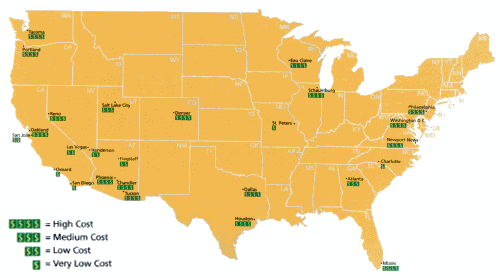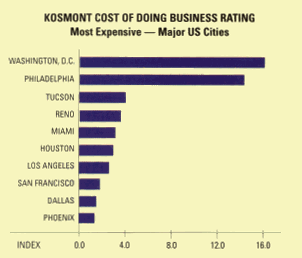S |
ite seekers evaluating California locations have used, for some time, the Kosmont Cost of Doing Business Survey, among other tools. Kosmont Realty Corp., Los Angeles, has gathered cost information on hundreds of communities in The Golden State.
This research has now been expanded to include 22 markets outside California, giving location evaluators a new tool with which to analyze relative costs. Included in the 2002 Kosmont Cost of Doing Business Survey are Philadelphia, Washington, D.C., and Newport News, Va., in the East; Atlanta, Houston and Charlotte, N.C., in the South; Eau Claire, Wisc., and Schaumburg, Ill., in the Midwest; and Reno, Nev., and Tacoma, Wash., in the West.
“We wanted to document the major markets,” says Larry Kosmont, president and CEO of Kosmont Partners (www.kosmont.com). “Los Angeles is a world class city, and many of the companies we know of that are looking at California are looking at Los Angeles from a regional perspective and making comparisons. They are evaluating Los Angeles with respect to other California locations, such as San Diego, San Jose or the Central Valley. And then they look at Los Angeles in light of other major markets, such as Dallas or Denver.”
Kosmont says he plans to expand the survey to additional markets, including such medium-sized metropolitan areas as Memphis, Tenn.
The survey currently rates communities according to four locally imposed costs: business taxes, telephone taxes, electric taxes and property taxes. These components are weighted in order to produce a final rating of one, two, three or four dollar signs, with four being the most expensive and one and two being the most cost-competitive (see map). “It’s a standard means with which to compare costs over multiple communities,” says Kosmont.

 Income Tax Will Follow
Income Tax Will Follow
Business tax rates are offered for eight business categories: general office, professional office, retail, wholesale, manufacturing, personal service, commercial property and residential property. Taxes include gross receipts, employee, payroll and flat rate or other.
Utility user tax rates are shown for electric, telephone, cellular, gas and water. Property and other tax rates included are estimated property tax, sales tax rate, transient occupancy tax rate and parking tax rate.
The survey also includes development impact/exaction fees, which include public facility fees, thoroughfare or bridge fees, and other impact fees.
Each city profile also includes economic incentives available, special zones (such as business improvement districts, foreign trade zones and others), as well as transportation amenities, including ports, rail, freight services and the freeway interchange ratio.
Besides site consultants, brokers, accounting firms and real estate departments, cities looking to gauge their competitiveness are frequent users of the survey.
Help Is On the Way
 Even given its unique attributes and challenges, the issues Kosmont sees as crucial to California are just as crucial nationwide: affordable housing, improved infrastructure, public-private partnerships and the need for “smart growth.”
Even given its unique attributes and challenges, the issues Kosmont sees as crucial to California are just as crucial nationwide: affordable housing, improved infrastructure, public-private partnerships and the need for “smart growth.”
“Now that we have expanded the survey to other states, we have noticed that Proposition 13 in California has actually protected California’s cost competitiveness,” relates Kosmont, referring to the ongoing reverberations of the 1978 tax reform measure that slashed property taxes by 30 percent and capped future rates of increase.
“Property taxes are less in California than in, say, Philadelphia, Washington, even Dallas,” he adds. “Those cities would be much more competitive than Los Angeles but for the fact that Los Angeles benefits from statewide Proposition 13.”
Nevertheless, in the Southern California market as a whole, Los Angeles is the most expensive city in which to do business, followed by Santa Monica, Culver City and Inglewood.
“Because Los Angeles has the highest business tax rate in the Southland, it has not been able to move quickly enough or far enough to keep more nimble neighborhoods from luring firms away,” says Kosmont.
The boom in the sublease market has tenants leaving long-term, expensive lease commitments in droves. “Unfortunately, high Los Angeles taxes can tip the scale against even a bargain sublease in the city.”
Kosmont says that “unfriendly legislation” passed or pending in Sacramento has made life more difficult for private developers by redefining the scope of the term “public works,” therefore putting upward pressure on wages for urban renewal projects because of the statutory requirement to pay “prevailing wages.”
Ironically, such rules may hurt the efforts of public-private partnerships founded to pursue the very redevelopment projects that rampant sprawl seems to warrant as a remedy.
But Kosmont’s branch operation Kosmont Financial Services is teaming with financing firm Neptune Co. to try to bring about a cure of its own. The Apex Equity Fund was launched in May with $100 million available for low-cost loans to cities entering partnerships with private developers.
“The Apex Equity Fund enables cities to preserve tax revenues by substituting low-cost loans in place of tax subsidy-based development assistance,” says Kosmont.
Neptune, founded in 1974 and led by Brent Nerguizian, converts long-term reimbursement agreements into immediate working capital. Apex loans, repaid from a project’s cash flow, are designed to bridge gaps normally filled by public assistance grants.
Such an option may be welcome in Kosmont’s home state, where municipalities are experiencing their own versions of California’s $17-billion budget deficit.
Meanwhile, even if some projects are held at bay, further expansion of the survey itself appears inevitable.
“We would like to explore the possibility of adding state corporate income tax information, because when you start comparing from state to state, that tends to be one of the key factors,” says Kosmont. “When you combine property tax, income tax and utility tax, you pretty much have the universe of key tax cost factors for most businesses.”

